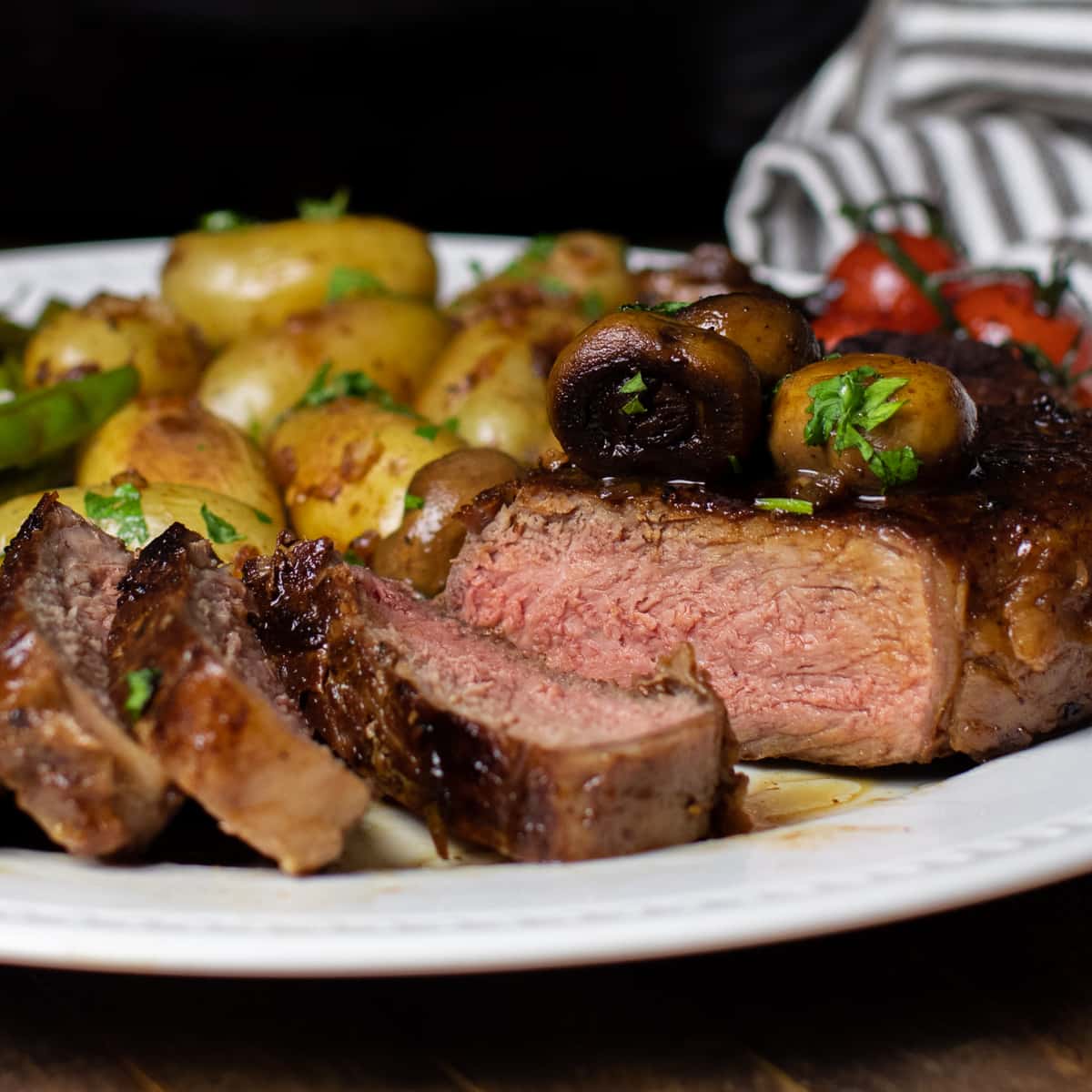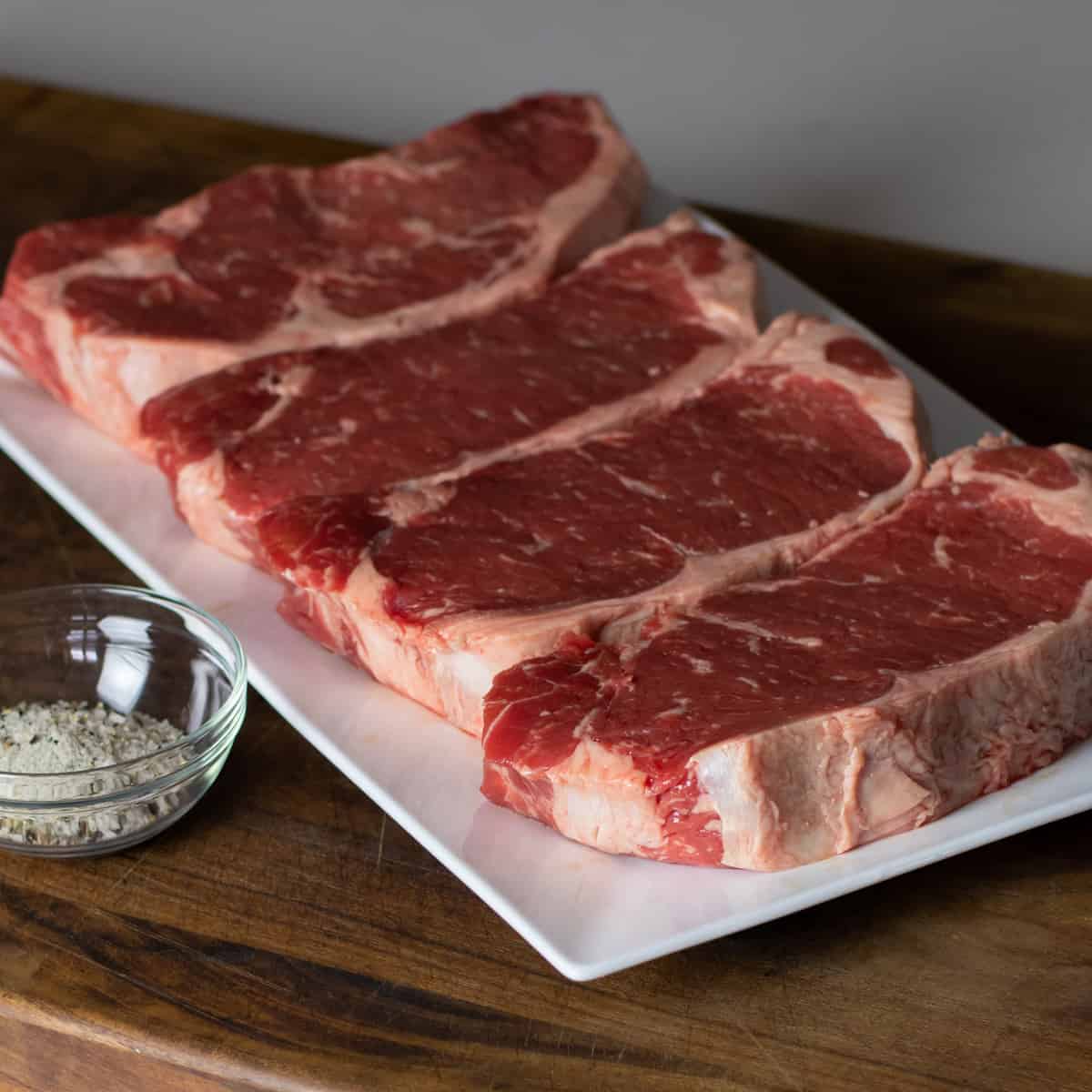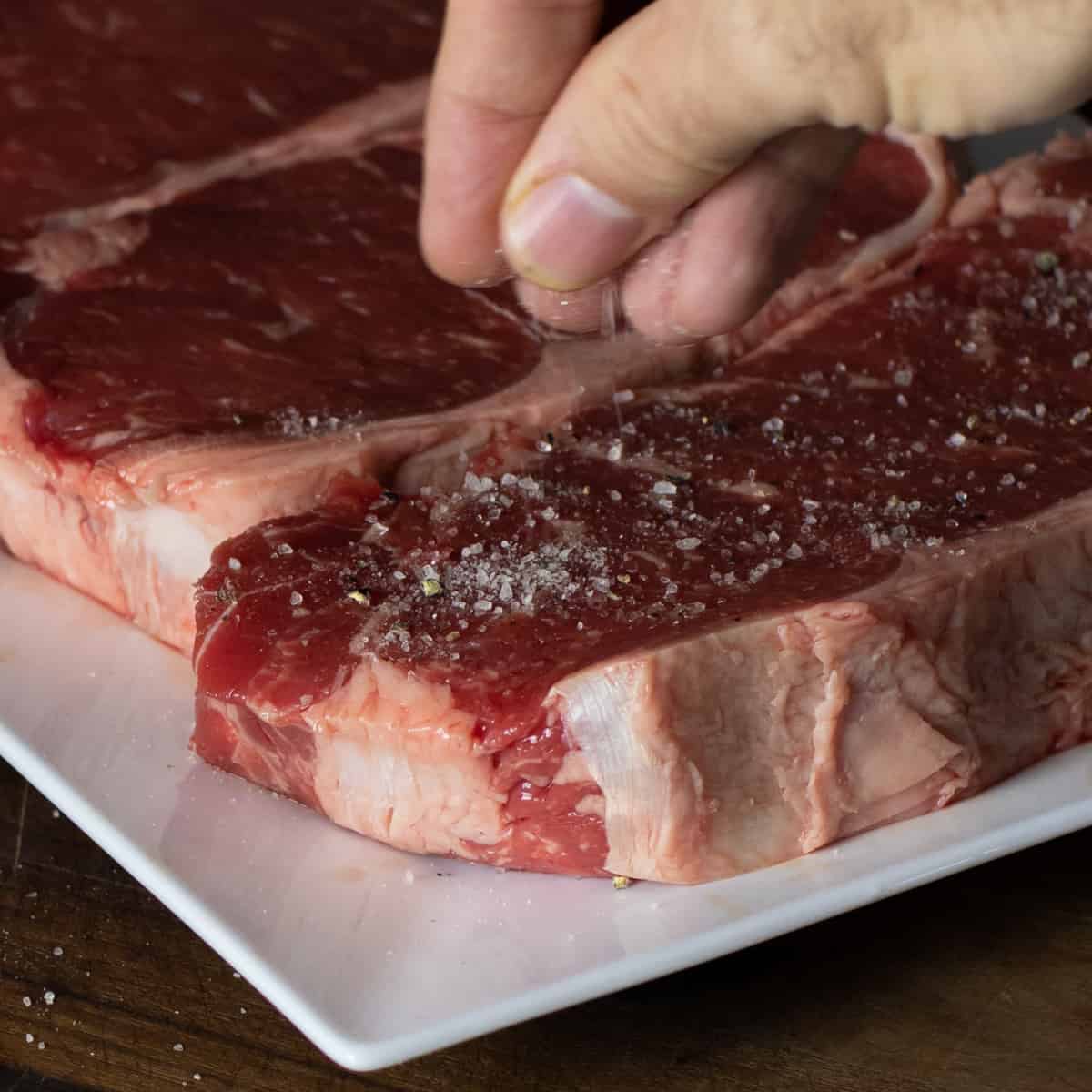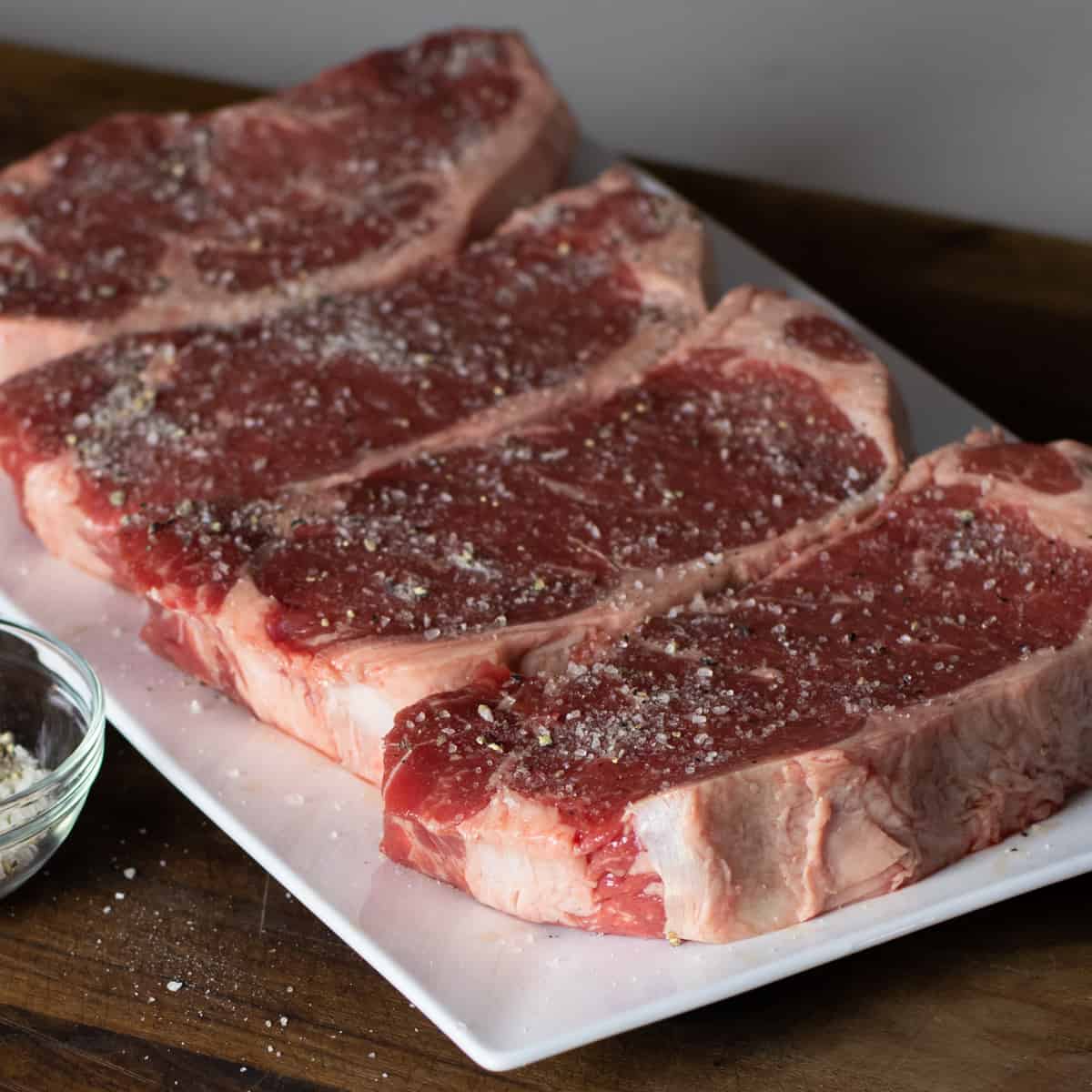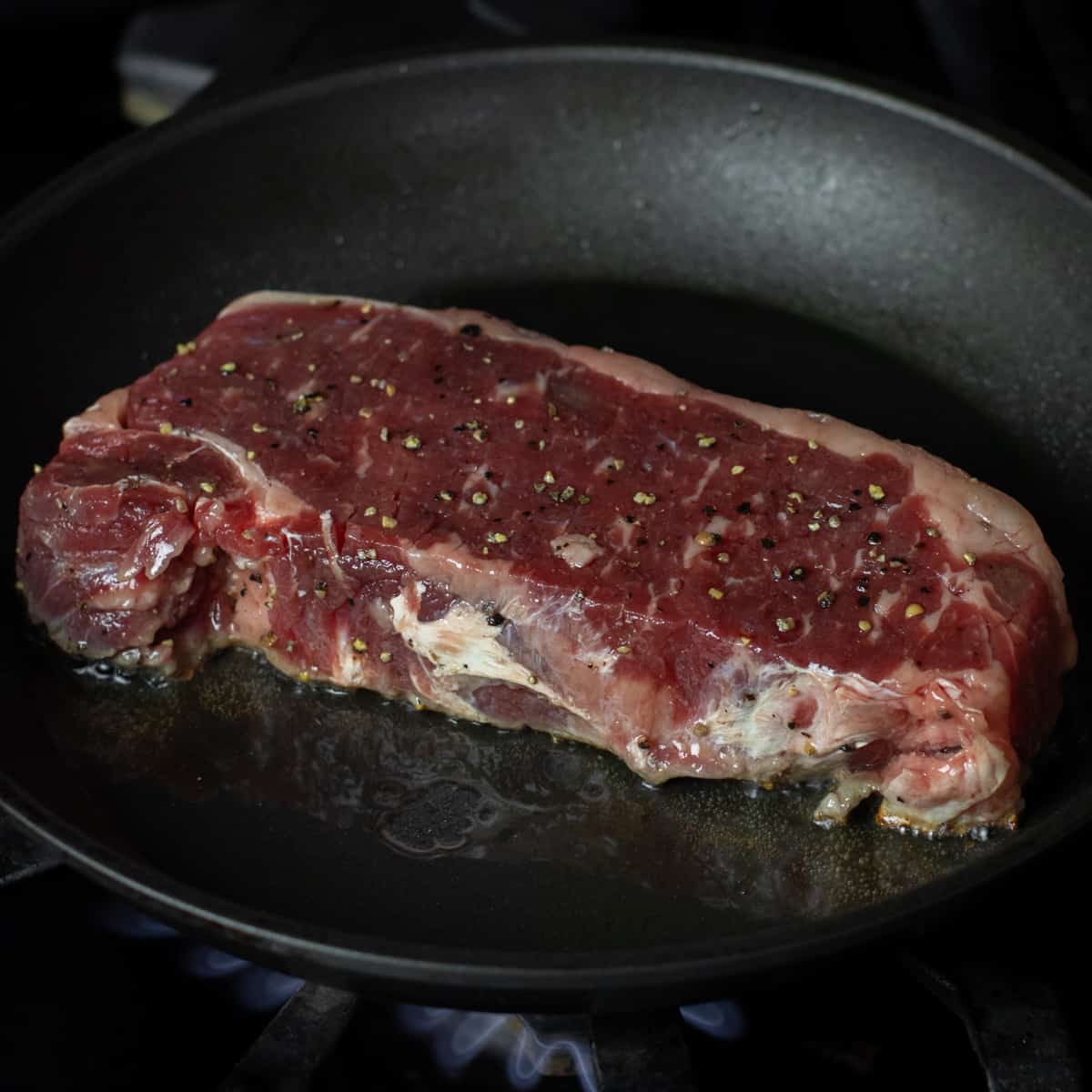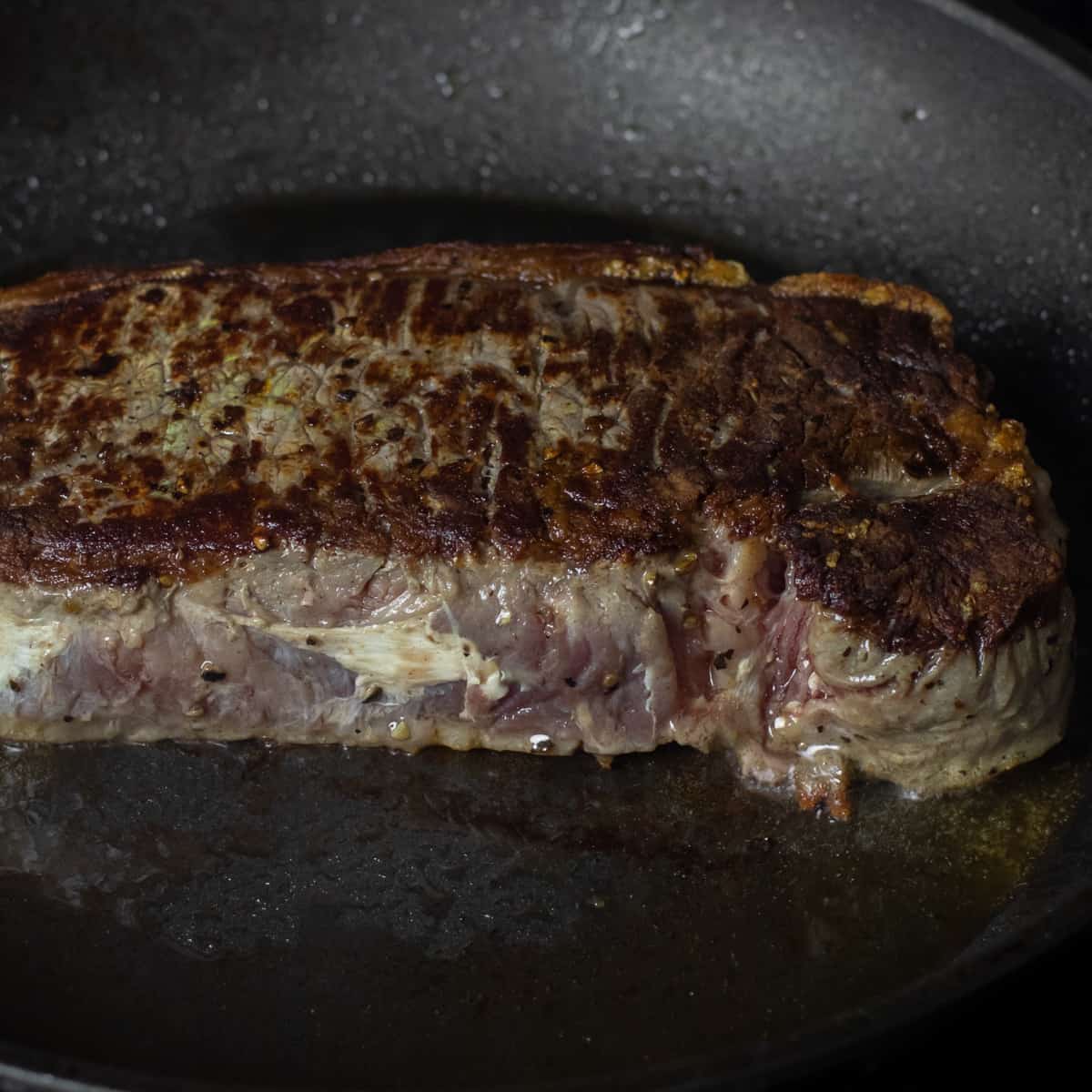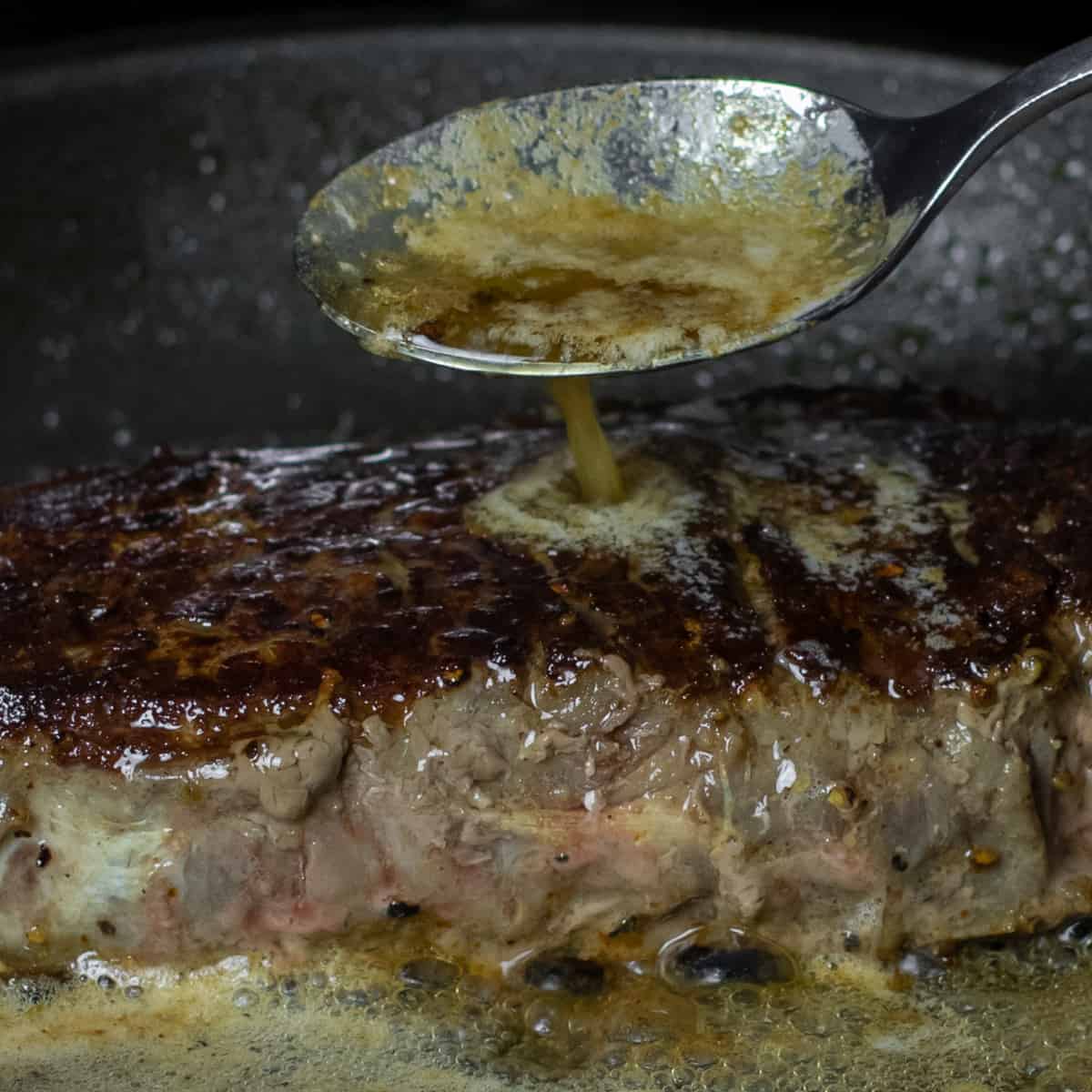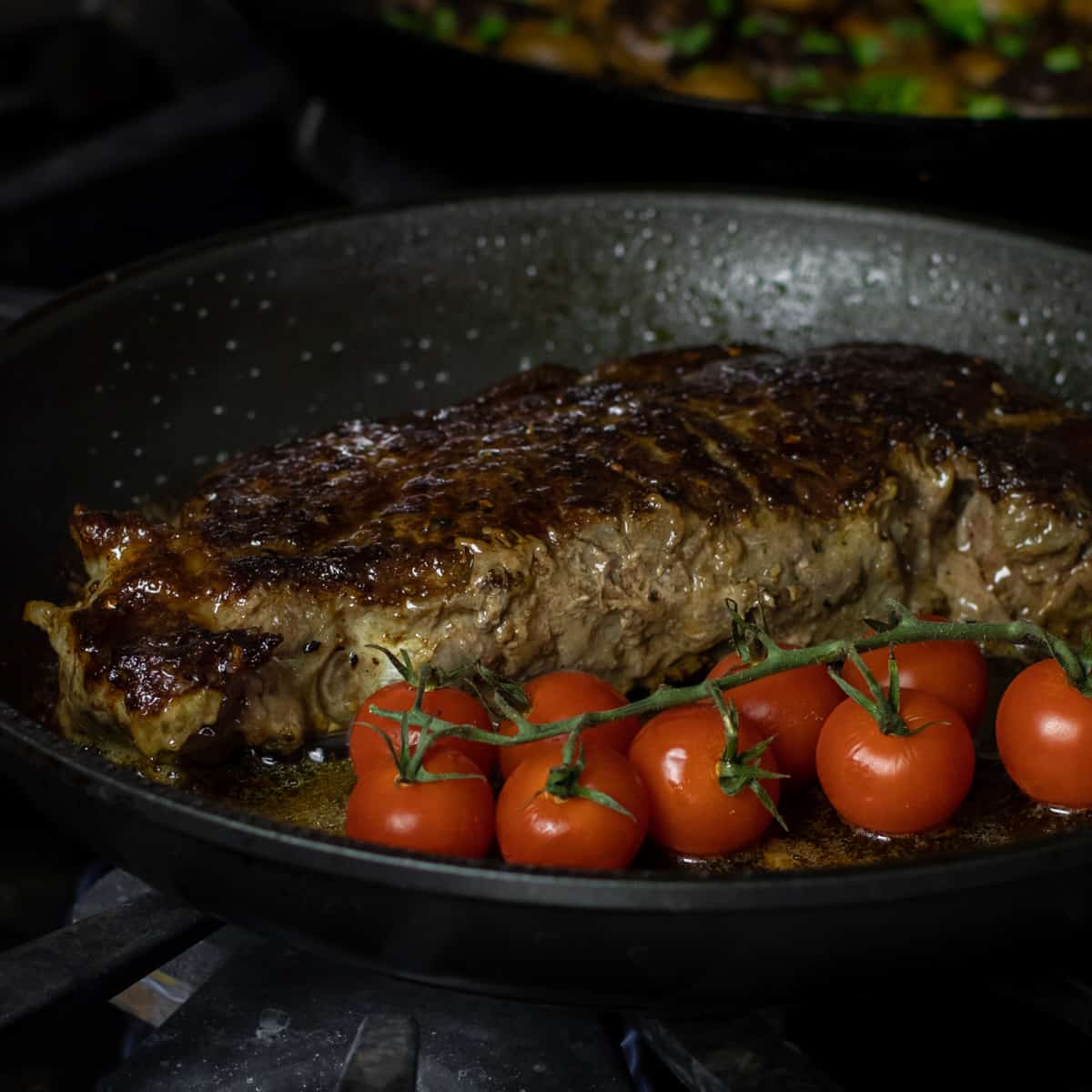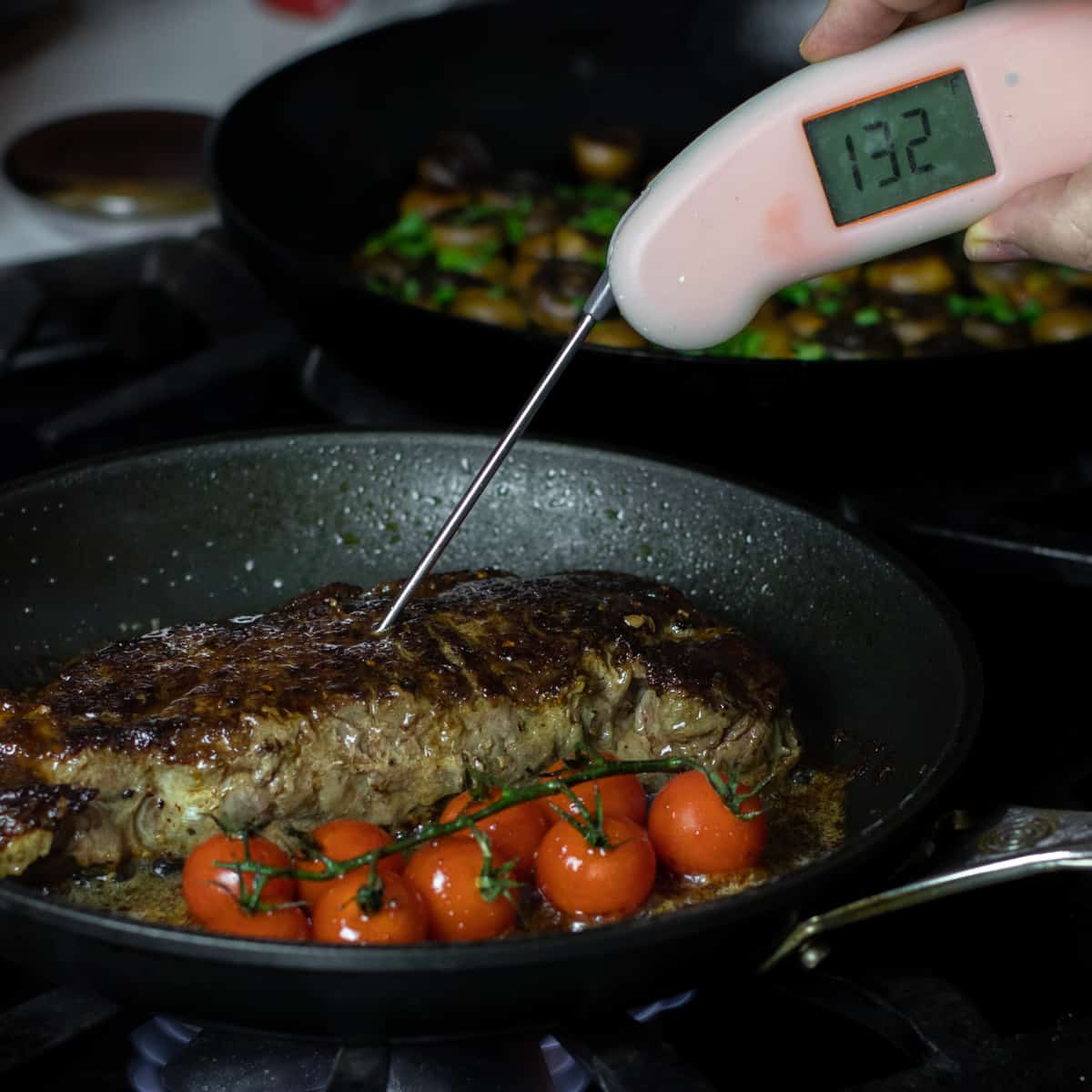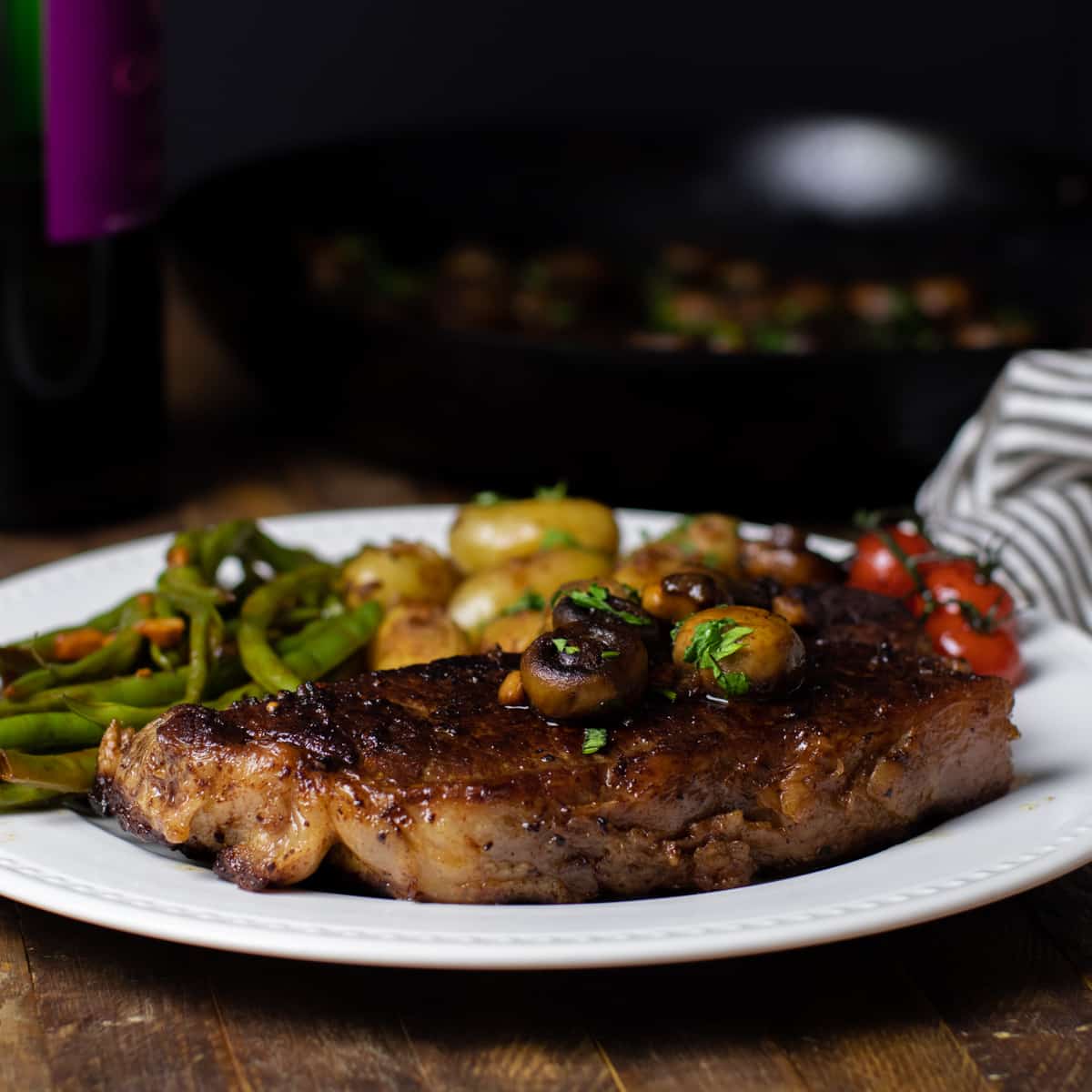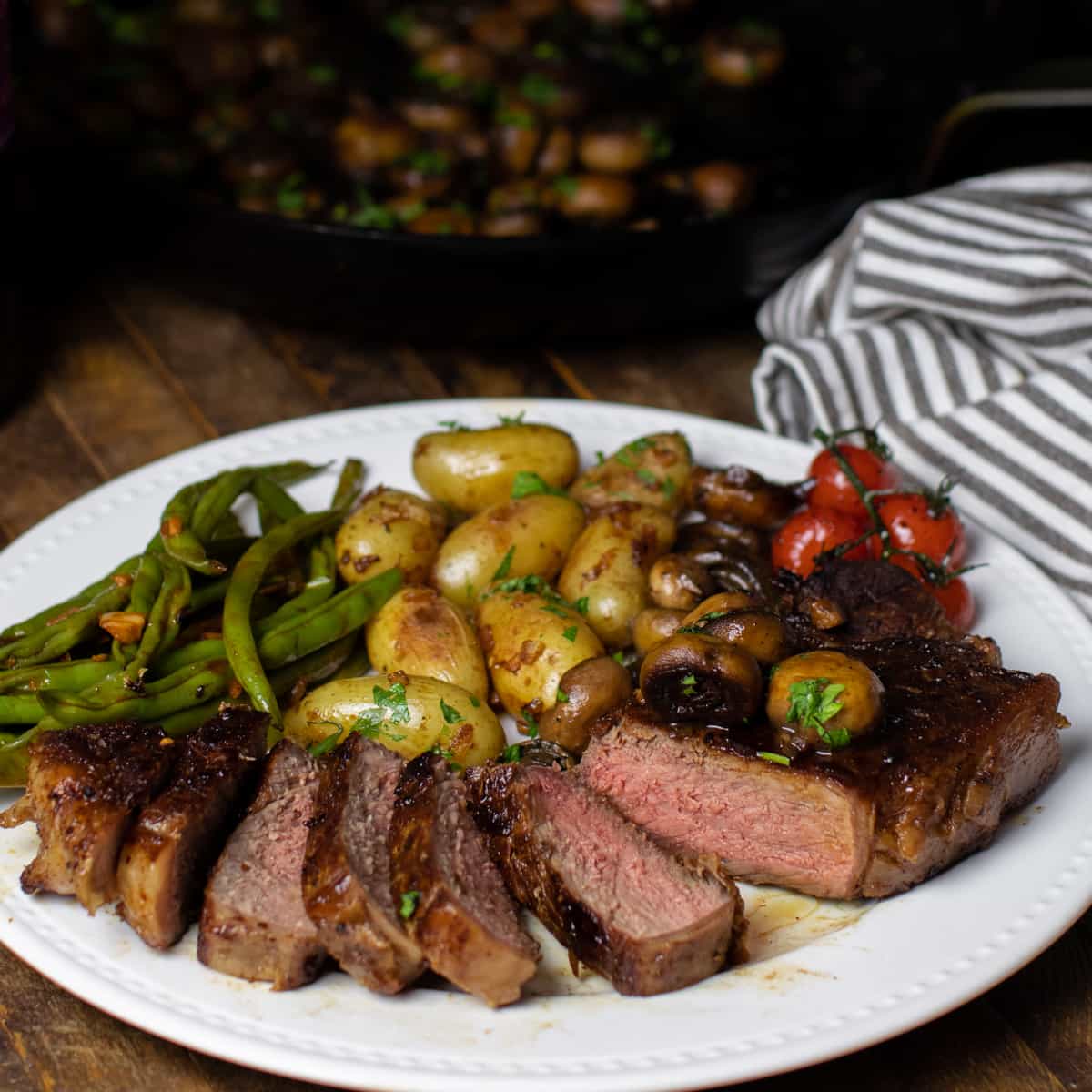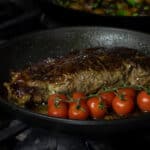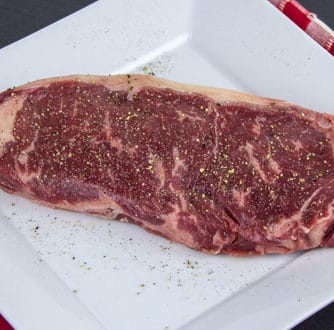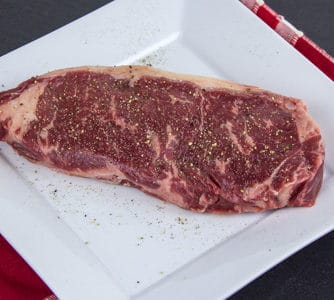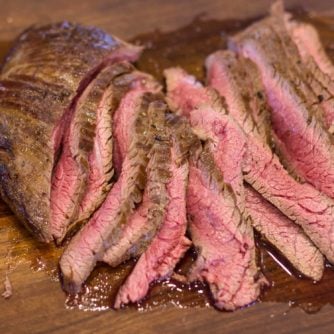How to Pan Sear a Striploin Steak
Cooking a striploin steak in a skillet is easy and this recipe will result in a tender steak that is perfectly cooked every time!
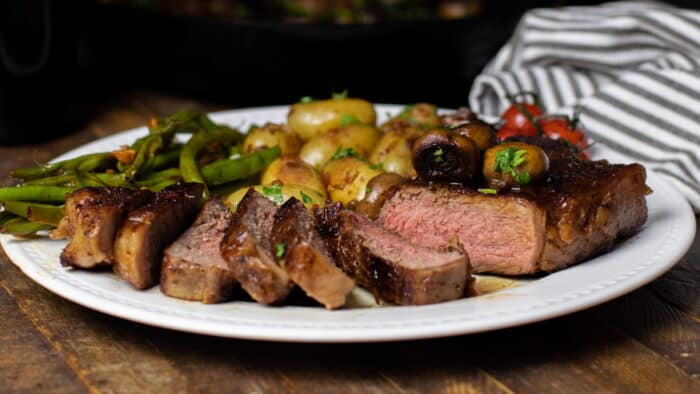
Pan seared steak is one of the dishes that I feel most comfortable to cook. I often make this when we have guests over for dinner and it always gets rave reviews. Many people have asked me how to pan sear a steak, and it could not be much easier than this recipe.
Striploin is my favourite cut of steak and for the longest time my preference was always to grill the steak. But, when I would go to a restaurant, and have a pan seared steak, I knew I needed to learn this method of how to cook a steak on a skillet.
For the last number of years, this is my go to method for steak. This recipe is very easy and honestly fool proof. Follow these steps and you will have a steak that is tender and delicious!
How To Choose A Striploin Steak?
A quick trip to the local supermarket to grab a few steaks can turn challenging if you don’t know what to look for. Not only are there different kinds of steak (striploin, ribeye, t-bone, sirloin tip, flank and more), but there are different thicknesses and qualities of the cuts of steak to look for.
- Thicknesses of striploin steaks typically are 1 inch or 1 1/2 inch. Both can result in a delicious steak, although the cooking time will vary. The steaks in the pictures here are about 1 inch. Sometimes the thickness is not consistent on the steak, with one side being a little thinner than the other. I try to avoid these steaks, as they would not cook evenly.
- Look for nice cuts that have consistent shapes. I have sometimes seen steaks at the supermarket that look almost mangled and were not cut cleanly. Look for steaks similar to the ones in the photo above where each steak has the same shape – this will ensure that as you are cooking, they should each cook the same.
- A striploin steak with lines or thin streaks of fat throughout the meat is called marbling and is nice, as it will melt/dissolve during cooking, and this will result in a steak that is very tender. Striploin steaks usually do not have lots of marbling, but they will likely have some.
- The cap of fat on the one side of the steak will help to keep the steak moist and juicy. Sometimes there is a lot of fat in the fat cap. Feel free to trim is back to be 1/4 to 1/2 inch in thickness. Anything thicker would be more than is necessary for a nice juicy steak.
Salt The Steak!
Before you cook the steaks, it is important to sprinkle some salt on them. This does more than simply seasoning the steak, as the salt will actually dissolve into the steak and brine the meat. This will allow the muscle tissues in the meat to break down and result in a tender juicier steak.
I like to use coarse salt and generously sprinkle the steak on all sides. Along with the salt I also typically season with some coarse black pepper and sometimes even some dried chili flakes.
Let The Steaks Rest After Salted
Let the steaks rest for a bit after they have been seasoned with salt. This method is a dry brine and the salt needs time to penetrate into the meat to tenderise it. If you cook it right away you are missing out on one of the functions the salt can provide, and instead, it is simply then just a seasoning for the meat.
I generally leave them for 1 hour after the salt is added. If possible, you could salt them the day before and leave them in the fridge uncovered on a plate if possible. Keeping the steak uncovered helps dry the surface of the steak which is better for searing.
After the steak has rested for an hour or so, the salt will usually dissolve and be absorbed into the meat as you can see in the image below. There is no need to rinse the salt away.
How To Pan Sear A Steak
Preheat the skillet to medium high heat.
Pat dry the steak with a paper towel. This is important because a dry steak will sear better and develop that nice crust on the outside and lock the juices inside. If a bunch of the coarse black pepper came off when patted with the paper towel, feel free to season with some more black pepper.
Add 1 tablespoon of oil to the skillet. Place the steak in the skillet and you will immediately hear a nice loud sizzle. Gently press the steak down as this will help the steak to develop a seared crust on that side.
After the steak has been in the frying pan for about 5 minutes, it is time to flip it over. Use some tongs and turn the steak over to the other side. You will notice that the cooked side of the steak as a beautifully browned crust. That is what we are looking for with a pan seared steak.
Baste The Steak With Butter
After the steak has been cooking for a few minutes more after being flipped over, it is time to add some butter to the pan.
Reduce heat to medium and place 1 or 2 tablespoons of butter and it will melt and start to bubble all over. Once bubbling, spoon the butter over the steak. Continue to do this, coating all sides of the steak with the bubbling butter.
Obviously, basting will add a delicious buttery flavour to the steak, but it does more than just add flavour. Basting will also cook the steak on the top and sides, as the hot bubbling butter is poured over. This speeds up the cooking and ensures that the steak is cooked evenly.
Add Any Herbs or Garlic?
There are many different aromatics that can be added to the butter during this last bit of cooking when the steak is basted.
Some options are chopped garlic, fresh herbs (rosemary, thyme), chili peppers.
I like the flavour profile of the steak to focus mostly of the meat, so I often stick with just the salt, pepper and butter. But other aromatics can give the steak a nice flavour profile.
I do like to add some cherry tomatoes to the pan. They don’t give any flavour to the steak, but as the tomatoes cook in the butter, they will absorb some of the flavour of the steak and seasoning. The tomatoes are quite tasty!!
What Temperature Should The Steak Be?
The finished temperature of steak is definitely a matter of preference and often debated by people. I personally like a steak that is somewhere between medium rare and medium. If the steak is dry brined with some salt, properly pan seared and basted with some butter, it will be tender and delicious at that doneness.
Some people prefer steak to be rare, while others prefer it cooked to a medium well or well doneness.
- Rare – 125F
- Medium rare – 135F
- Medium – 145F
- Medium well – 155F
- Well – 165F
Use a digital thermometer to check the temperature of the steak. Be aware that the steak will continue to rise in temperature even after it has been remove from the pan. I like to remove the steak when it is 5F to 10F below the desired finished temp knowing that it will likely rise up to that temperature while resting on the plate.
Let The Steak Rest!
Allowing the steak to rest for 5 to 10 minutes after it has been removed from the hot skillet will draw the juices back into the meat. Also, as the steak cooks, the muscle fibres of the meat will tighten up and constrict. Resting gives the meat time to relax and you will find each bite nice and tender.
Great Side Dish Recipes!
If you are looking for a side dish to go with this pan seared striploin steak, then check out these options!
- Sautéed Mushrooms
- Lemon Garlic Fingerling Potatoes
- Sriracha Garlic Green Beans
- Oven Roasted Baby Potatoes
- Mashed Potatoes With Chives and Pecorino
How to Pan Sear a Striploin Steak
Ingredients
- 1 striploin steak
- 2 tsp coarse salt
- 1 tsp coarse black pepper
- 1 tbsp oil
- 2 tbsp butter
Instructions
- Generously season all sides of the steak with the salt and pepper. Place on a plate and let rest for one hour.
- Heat oil in a frying pan over medium high heat.
- Pat the steak dry with a paper towel. Place the steak in the frying pan and cook for 4-5 minutes.
- Use tongs to flip the steak over to the other side. A seared crust should have developed on the cooked side of the steak.
- Continue cooking for 3-4 more minutes.
- Add the butter to the pan and lower heat to medium.
- Continually spoon the melted butter over the steak. After a minute or two, turn again and keep basting with the melted butter.
- Cook until it reached a desired level of doneness.
Notes
- Rare - 125F
- Medium rare - 135F
- Medium - 145F
- Medium well - 155F
- Well - 165F
Nutrition
Per serving:

